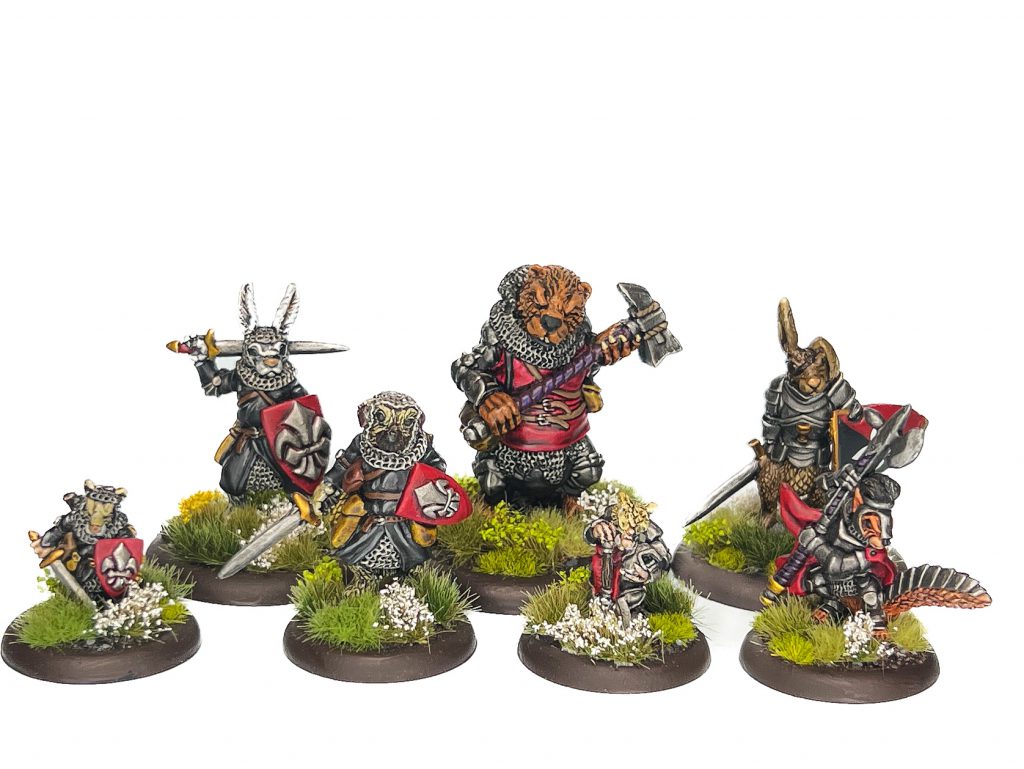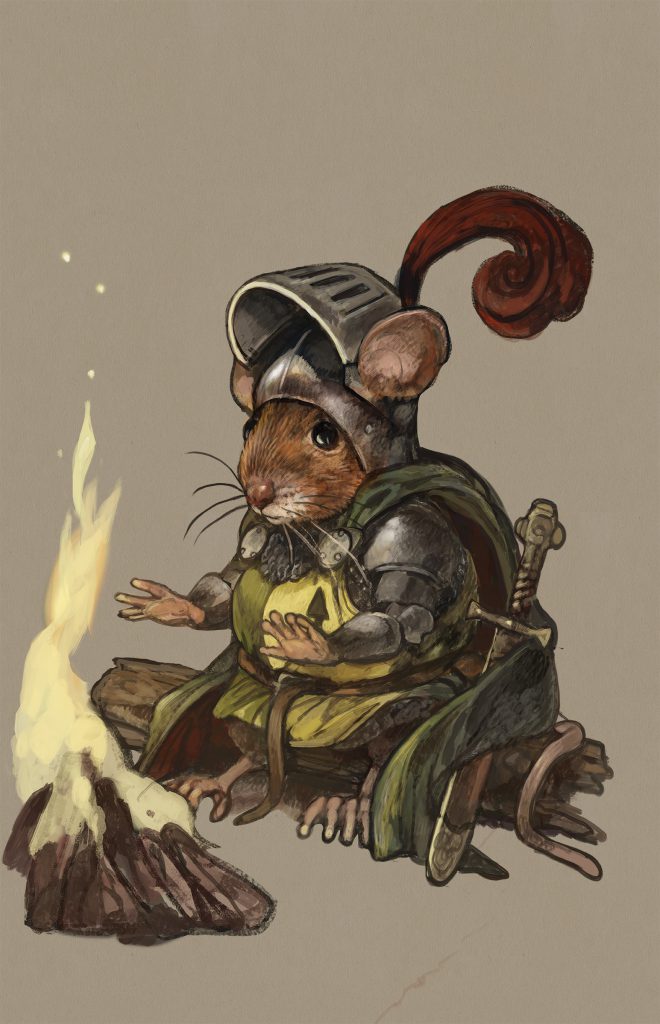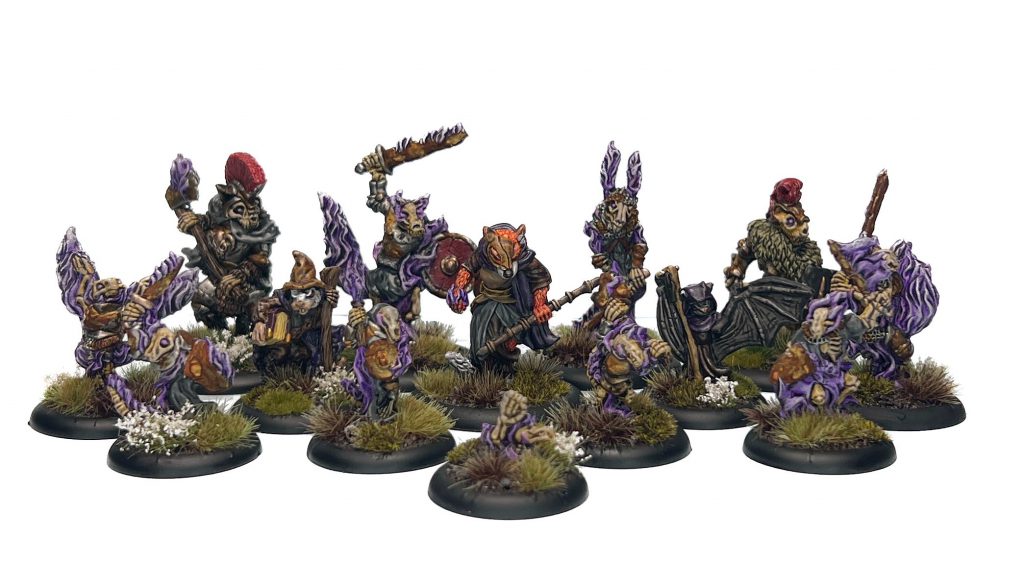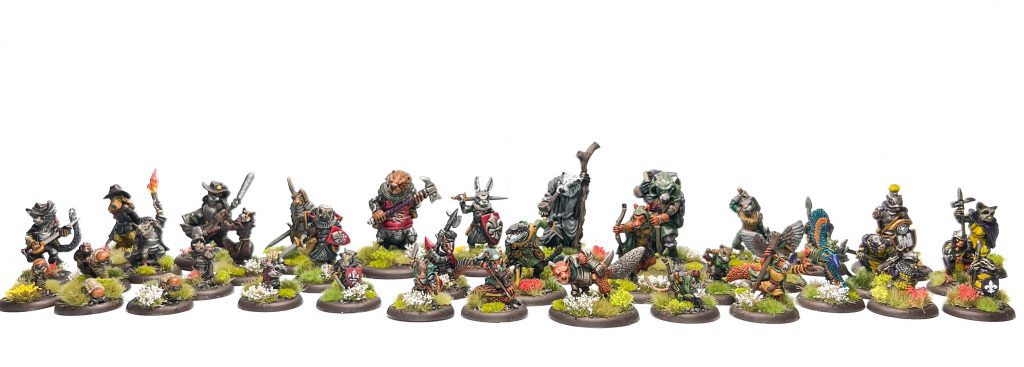If you’ve stumbled across this but are unfamiliar with Burrows and Badgers then welcome! In short, this is an anthro fantasy skirmish game where you build your warband of assorted animals, kit them out however you like and adding magic into the mix if you so choose. The creator, Michael, previously sat down for interview to talk about his miniatures, the game, and where the idea came from so go read that if you haven’t. A thank you to Osprey for providing us a review copy of the rules.
It’s here! Or, depending when you’re reading this, very nearly here. The second edition of Burrows and Badgers by Oathsworn Miniatures, the small company that designs the game and all of the hand-sculpted miniatures cast in single piece metal (some “massive” ones are in resin). By my count in early April they have a staggering 236 miniatures in the range. We have covered Burrows and Badgers in the past having become a fast favourite among some of our writers and we are very excited for the new edition.
One note before diving in: Burrows and Badgers is very much a narrative/campaign based game. We’ve played plenty of one-offs with starting warbands which is lots of fun but the rules and roster really lend itself to a more narrative mindset.

What We Love
- Allegiances (Factions) feel more unique and thematic
- Actions are more interesting while being simpler – creates a better flow of gameplay
- Gorgeous artwork and overall great quality of the book
- Collating all of the previous Oathsworn Journals into core rules
- Hiring named characters!
What’s In the Book
Everything you need to play the game, barring dice, miniatures, and objective markers. The contents reads:
- The Rules
- Creating a Band
- Magic
- Equipment
- Skills
- Campaigns
- Quests (and side quests!)
- Appendix, Band Roster, and Credits
This will be very familiar to returning players and largely what you expect to find in a skirmish game’s rulebook from its core rules all the way through to playing your first camapaign.
Before diving into the rules there are three pages of setting going into a bit of detail of the kinds of anthro animals you’ll find here and can recruit into your warband. We also can’t say enough good things about all of the incredible art by Peter Johnston. While writing this review I’d stop and just look at the art as I flipped pages a little too often!
Across the first edition of the game they released a number of Oathsworn Journals for free which added new animals to recruit, new types of warbands, and new equipment for them; these have all been collated and added to the second edition book as standard.

What’s New and Changed
There’s a number of changes here and we largely think these are all positives. This is still the game you love as a returning player, just with some tweaks and adjustments for both ease of play and likely balance.
- Disastrous Rolls when rolling a natural 1
- Fate Points are limited use per model instead of ten per warband
- Initiative is rolled off using a models’ Initiative stat; a player can try to “seize the initiative” as well
- Actions are two per model per activation, following a standard for skirmish games (ie Move then Shoot) with a penalty if you attempt the same action twice
- New actions Focus and Barge
- Overhaul of the Skirmish and Ambush actions removing some tedious math
First things first: every player now needs to have three objective markers for their games. These can be anything but are “ideally 30mm across” and Oathsworn do sell a few if you don’t want to make up your own.
Perfect Rolls stay the same, but now we also have Disastrous Rolls! On a roll of a 1, the model gains 1 fate point that can be used later in the game (assuming they even survive after rolling that 1, ouch!). Sounds like this has been implemented to help give the model one last chance at redemption, before ultimately snuffing it.
Speaking of Fate points, rather than being given ten at the start of the game to use across your warband as you see fit each model now gets a set number to start with: Leaders 3, Seconds 2, and the rest just 1! There are ways to increase this, such as the Disastrous Rolls. In 1st edition fate points were used to add an extra dice to your roll-off choosing one of the dice as the result; now it’s a re-roll if you aren’t happy with the first roll and can re-roll your re-rolls at the cost of more fate points. They can also be used for a bonus when using certain skills or spells. Lastly, they can be used to seize the initiative, which brings us onto…
Initiative. Previously this was a roll-off between the leader’s Presence against your opponent leader’s Presence. In the new edition you each pick a model in your warband and roll-off using that model’s Nimbleness. If you win, you must activate that model first. This creates some tension where you may want to try and use your highest Nimbleness model but may need to activate a slower one instead. I like the choice that this creates and forces on the players as they go through the game. After this first model activates, players take it in turns to alternate activating models that have not yet made any actions. This sequence can be interrupted by the any player (typically your opponent, though in 3+ player games this becomes very interesting), who can spend a fate point to have their model activate immediately, which is called Seizing the Initiative. This can be countered by another player, at which point both players spend their fate points to do a Nimbleness roll-off and see who wins. This is an interesting change, and perhaps one of the more powerful uses for fate points as it could let you activate several models in a row to try and control the board. It’s also very similar to Middle Earth Strategy Battle Game and how players spend Might points to move before their opponent. For a number of reasons your Fate Points are going to be a precious commodity that you’ll learn to spend wisely…or use in your first turn trying to hit as hard as you can! One or the other.

Actions
How Actions work have changed up slightly. You previously would pick an action, which would typically consist of a ‘move’ followed by the action itself. Now you get to pick two actions. These can either be two different actions, or the same action twice. Note that if you perform the same action twice, you will suffer a -2 modifier to your roll-off. Feel free to keep attacking that mouse, but after a while your arm will start to get tired!
Most of the actions we are familiar like Move, Charge, Attack, or Shoot with some changes to suit the new actions sequence, but there are a few new ones worth mentioning. First is Focus, allowing your character to use their first action to prepare for the next action and earn a +2 modifier (take aim and fire!). Another new action (and one that really sparks the urge to roleplay out the action) is called Barge. Just hearing this word paints a good picture of what it does! If your model is the same size or larger than your target you can charge into them and push them up to 2″ in any direction other than behind your barging model; think of it as barging in and grappling them or shoving to one side. This is a great support move to help save another model stuck in a losing combat or to literally Barge somebody off the edge of terrain and force them to fall! You can even Barge them off the edge of the battlefield, which forces them to lose their activation for that turn if they haven’t gone yet since they won’t return to the table until next turn. Just imagine Badgers barging all manner of smaller creatures off of precious ledges, into streams or pods, or even into a position to be better ganged up on by the rest of your warband.
Some added depth to moving including going through tight gaps (spaces more narrow than a models base) and some restrictions placed on the width a model may “fly” through is great to see; even more so since they can get stuck in the process! I love the narrative implications of a cat trying squeeze through a more narrow space than it should chasing after a mouse. I can see a mouse being added to one of my warbands soon and naming him Jerry…
Movement otherwise is the same as before, using the highest value of the dice type (a D8 move is 8″) without needing to roll. However, if you are Charging, Barging, or Sneaking then the movement is treated as ‘Difficult Terrain’ which requires you roll for the movement. This is a massive change that can be hard to spot but means that none of your charges or barges will ever be guaranteed! If you fail to move into base contact you still have to move the distance rolled directly towards the target, too, possibly putting you in a poor positon. The upside? Charging gives you an immediate free attack with +2 to the result if the model moves at least 3″ before making contact. If you Focus before Charing you’ll get +2″ to your move AND a further +2 on your free attack making that both an easier charge and up to +4 on your attack roll, potentially very nasty.
Speaking of Sneaking, this has changed up quite a bit to remove the complicated maths around it (having to count up how many models have line of sight, within 12”, within 6”, etc etc). If a model enters Sneak as their first action they can delay their second action as you could in the previous edition. They can then later interrupt the turn sequence by taking their second action. In the case of a Charge or Shoot action, this is known as an Ambush, and the defending model must use their Awareness Stat rather than a normal Block or Nimbleness. Again, this takes away a lot of the annoying maths and simplifies things, which I am a big fan of! Another interesting note is that actions can now target someone sneaking, and the sneaking model can use their concealment stat for defence rolls. Shooting and casting attacks that are outside of 6” suffer a -2 modifier. This change feels like it tackles an issue with 1st edition sneak, where entire warbands could sit hidden with nothing going on for half the game, waiting for someone to poke their big bunny ears out. I always found this frustrating, and slowed the game down a lot, and made some objective games much less interesting to play.

Allegiances (Factions)
Allegiances now have a lot more individual flavour and feel much more unique and I love this. It’s perfect for this scale game while still not being too much to keep track of either!
The allegiance you choose will shape how your warband plays and what equipment you want to (or even can) take making them feel much more thematic. Choosing your allegiance, in most cases, adds extra equipment that you’re allowed to buy for your models as well as restrictions on what they’re allowed to take. For example, Kindred can take master-smithed weapons, War Bows, and Silk Undershirts but aren’t allowed any heavy armour or heavy shields.
Each allegiance also comes with their own Support Quests that are active during each game giving your critters an extra way to gain experience and fate points during the game. These range from simply killing enemy characters to more complicated ones requiring you to get to enemy objectives and perform an action on them. These are all very thematic to the given allegiance, though, like the Witch Hunters earning theirs by taking out enemy Leaders and Seconds as well as any enemy magic users or characters with the Uncanny skill; you can definitely imagine a Witch Hunter warband gunning straight for these kinds of models already out of narrative necessity so gaining something extra for doing so feels great!

Equipment, Skills, and Spells
Since this rulebook collates all of the previous Oathsworn Journals you have many more choices straight out the core book on how to equip your warband, what skills some can start with, and what spells they can know!
Just about any model from any allegiance (yes, even you Witch Hunters) can start as a wizard/witch/mage/etc knowing any number of spells you like. Each spell a model starts with incurs Weak (1) and Delicate (1) on them, which stack with each spell taken! So yes, you could have an incredibly powerful mage that knows 5 spells otu the gate but they’re going to have Weak (5) and Delicate (5) making them much easier to take out of action during the game.
As far as equipment goes you’re not going to be found wanting, there are 24 pages dedicated to just arms, armour, and any other item you could want to start out with! Some top picks for me are Camouflage Cloaks for sneakier warbands, Old One Brews to keep your characters fighting even after badly injured, and torches and lanterns which let you play games in the dark more effectively. Time to set up some nighttime raids!
Let’s not forget skills, either. As I mentioned right at the start, this really is a game that is better played as a campaign keeping an ongoing roster of your warband as they level up and gain skills (or as they get injured and need to be replaced!). When starting out only your Leader and Second get to start out with a skill, all the others will need to learn as they go!
A great change this edition is adding in both a “type” and “requirements” section right above each skill making it clear what other skills you’ll need to know first or even requiring a point of Fate to be spent when using the skill! Making you use one of your very limited Fate points is a great way to help balance the more powerful skills and will make you question how often and when you’re going to use it instead of just every turn. Also nice to see some existing skills toned down and changed to fit the new edition, one that comes to mind is Burst of Speed which used to allow an insane amount of movement and now simpoly adds 4″ to a Move or 2″ to a Charge; still very powerful but is one that requires a Fate point to be spent!

It’s Good, Folks
There really is not enough good things we can say about this book. To me, this is exactly what you want a second edition of a much beloved game to be: clean, concise, and adding in the strewn-about bits from the first edition.
I really cannot wait to get my minis back on the table and get a campaign running. Attacking stagecoaches, rescuing members of my band taken prisoner, and of course hunting down moles! What more could you want?
Have any questions or feedback? Drop us a note in the comments below or email us at contact@goonhammer.com. Want articles like this linked in your inbox every Monday morning? Sign up for our newsletter. And don’t forget that you can support us on Patreon for backer rewards like early video content, Administratum access, an ad-free experience on our website and more.


